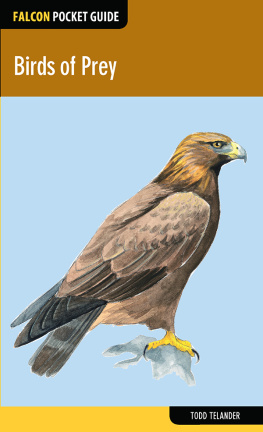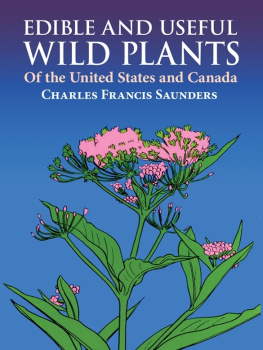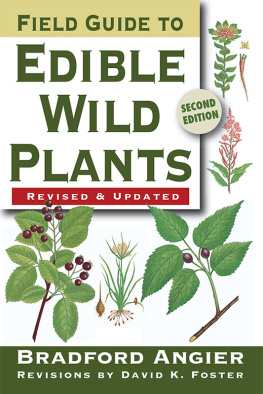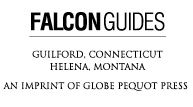Edible Wild Plants
Todd Telander
To my wife, Kirsten, my children, Miles and Oliver, and my parents, all of whom have supported and encouraged me through the years.
Special thanks to Gary Lenz for sharing his knowledge of plants.
2012 Morris Book Publishing, LLC
Illustrations Todd Telander
ALL RIGHTS RESERVED. No part of this book may be reproduced or transmitted in any form by any means, electronic or mechanical, including photocopying and recording, or by any information storage and retrieval system, except as may be expressly permitted in writing from the publisher. Requests for permission should be addressed to Globe Pequot Press, Attn: Rights and Permissions Department, PO Box 480, Guilford, CT 06437.
Falcon Field Guides is a trademark and Falcon, FalconGuides, and Outfit Your Mind are registered trademarks of Morris Book Publishing, LLC.
Text design: Sheryl P. Kober
Layout: Sue Murray
Project editor: David Legere
Library of Congress Cataloging-in-Publication Data is available on file.
ISBN 978-0-7627-7421-0
The author and Globe Pequot Press assume no liability for accidents happening to, or injuries sustained by, readers who engage in the activities described in this book. Neither the author nor the publisher in any way endorses the consumption or other uses of wild plants that are mentioned in this book, and they assume no liability for personal accident, illness, or death related to these activities.
Contents
ALGAE
HORSETAILS
FERNS
GYMNOSPERMS
ANGIOSPERMS: MONOCOTS
ANGIOSPERMS: DICOTS
Introduction
Learning about edible wild plants not only will provide you with some extra food but also will inevitably lead you on a path of discovery about the natural world and our connection to it. Many of the plants we walk past every day, see as ornamentals, or destroy as weeds are indeed edible, delicious, and filled with nutrients. It takes only a few moments and some thoughtful observation to learn enough about a plant to know its value as an edible, but you can spend years delving deeper into its life cycle, place in the ecosystem, and history of use by native peoples. So, the next time you pull a weed from your garden, chances are you could be eating it for lunch.
This guide covers ninety of some of the more common edible wild plants in the United States. Of course, you can learn about many more by reading comprehensive field guides, taking courses taught by experts in the field, or studying native cultures. Plants included in this guide represent a diversity of families, environments, and regions. From algae to flowering plants, deserts to the sea, an outdoor buffet awaits!
Note: Collectors should inquire regarding local regulations on public lands prior to collecting wild plants, especially in national parks, where such actions are generally prohibited or limited by type and quantity.
Notes about the Entries
Order
The order of plants listed in this guide is based loosely on phylogenetic relationships, from the simpler, early plants to more complex, later plants. The algae are unicellular plants that grow only in water because they lack supportive stems and a vascular system. The ferns and horsetails are early land plants that lack seeds and reproduce instead by spores. Gymnosperms, such as the pines, lack flowers and have seeds that are borne in cones. The angiosperms are the largest, most familiar group, with flowers and seeds borne in some kind of fruit.
Names
The common name(s) as well as the scientific name are included for each entry. Because common names tend to vary regionally, or there may be more than one common name for each species (some plants have over a dozen common names), the universally accepted scientific name of genus and species (such as Rumex crispus for curly dock) is a more reliable identifier. Also, one can often learn interesting facts about a plant from the English translation of its Latin name. For instance, the generic name Rumex is Latin for a kind of sorrel, and crispus means wavy or curly, describing the curled leaf margins of the curly dock.
Families
Plants are grouped into families based on similar structures, growth habits, and common ancestry. After you are familiar with some of the more common plant families and their shared characteristics, you can often place an unfamiliar plant into a family, which will reduce your search to a smaller group. For example, if you find an herbaceous plant with a five-petaled flower; alternate, serrate leaves; and a prickled stem, you might first look in the family Rosaceae (which includes wild roses, blackberries, and cherries) and narrow your search from there. You may find a diagram for leaf shapes, margins, and terms on page 1.
Size
The size given for each plant is the maximum size you are likely to find and occurs when environmental conditions are ideal and you are looking at a fully mature specimen. If conditions are less favorable, or if you find a specimen early in its growth cycle, the plant may be much smaller.
Range
The range of each species can be very wide, such as across the entire United States, or limited to a certain region, such as the Southwest or Northeast. Within a plants range, it is important to note the specific habitat where it occurs.
Season
The season listed is when the plant is actively growing. If there are specific times when an important plant part, such as flowers or fruit, is available, those times are also indicated.
Habitat
A plants habitat is an excellent key to identification. Although some nonnative, invasive plants grow almost anywhere, most have fairly specific environments where they prosper. Factors such as soil conditions, temperature, water availability, elevation, and surrounding vegetation all play an important role in a plants ability to survive. You wont find wild rice growing in the desert or catclaw growing in swamps. One exception is plants that are used as ornamentals, which may be found far from their natural habitat.
Descriptions
The descriptions give the basic structure and growth habit of each plant, including its life cycle, stem shape, leaf shape and arrangement, flower details, kinds of seed or fruit, and root form. They are not comprehensive descriptions but are designed to include essential information to help in your identification process. Other clues may include hairiness (or lack or hairs), spines, textures, and odors. Some plants may be obvious and unique, whereas others are so similar that they may require the use of additional references to ensure proper identification.
Uses
This book is designed primarily to address the edibility of wild plants, although in some cases medicinal qualities or structural uses are also noted because they may be of particular interest. Often, the timing of your harvest is crucial to how a plant part will taste, particularly with leaves, which often become quite tough or bitter if picked too late or from an older part of the plant. Unripe fruits are usually unpalatable, and roots and tubers taken during the growth cycle of the above-ground plant will be small and fibrous. Some plants have parts that are delicious eaten raw, whereas others have parts that must be cooked (either to have better flavor and texture or to remove toxins). Always consult an expert before eating any wild plant because some that look like edibles are highly poisonous.








